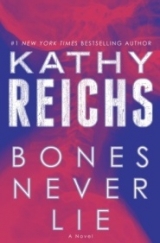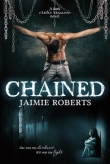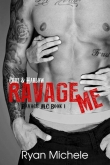
Текст книги "Bones Never Lie"
Автор книги: Kathy Reichs
сообщить о нарушении
Текущая страница: 11 (всего у книги 21 страниц)
CHAPTER 21
THE SNOW STARTED as we crossed the Champlain Bridge. Turned to sleet as we hit Stanstead, just north of the border.
I watched the wipers chase fat flabby flakes, later slush, from the windshield. Now and then a wind-tossed leaf hit the glass and was whipped free, brittle and shiny with moisture.
The car’s interior smelled of wet leather and wool. Stale cigarette smoke.
“Look for the Passumpsic Cemetery.”
The first words Ryan had spoken in almost two hours. I was good with it. After he’d relayed what he knew, which was virtually nothing, we’d both burrowed deep into our own thoughts.
Occasionally, I’d check my iPhone. An email with an attachment arrived from Slidell just past noon. I downloaded and enlarged the image.
You’ve seen pictures of Charles Manson. No matter what his age is, his eyes send a frigid wind knifing straight through your soul. His hair may be shaggy or shaved, his cheeks full or gaunt. You feel like you’re gazing straight into the heart of evil.
That’s how it was with Pomerleau. She was in her teens when the sole existing photo was taken. Now she would be thirty-nine.
The computer had softened the jawline, drooped the lids, and broadened the lips and facial contours, transforming the child face into that of a woman. Still the eyes looked stony cold, reptilian, and unfeeling.
As they had on our last encounter. When she’d doused me with accelerant, then coolly lit a match.
I did as Ryan asked. We’d just passed through St. Johnsbury, were now seeing mostly farm fields, trees, a few clusters of homes.
“There.” I pointed to the cemetery. It was old, with headstones and pillars, rather than ground-level plaques for the convenience of mowers. A perfect Poe tableau in the wintry gloom.
Maybe a quarter mile more, then Ryan slowed, signaled, and made a left from Highway 5 onto Bridge Street. We passed a church, a general store and post office combo, a gray building with an old red auto seat on the porch and a red plastic kayak affixed to the top of the front overhang. Passumpsic was written in white on the kayak’s side. A wooden sign above the door identified the Passumpsic River Outfitter, LLC.
Just beyond the outfitter was a bridge, a narrow latticework of metal girders and wooden beams painted green. Not the covered New Englander I’d envisioned. The Passumpsic River looked dark and menacing as we crossed over. On one bank, an ancient brick power station.
Soon the road’s name changed to Hale. Forest took over on both sides. Lofty pine, less lofty spruce. Hardwoods, their branches nude, their bark black and sparkly wet.
Then there were no homes, no barns. Just the Hundred Acre Wood.
Seven minutes of silence, I kept checking my watch. Then Ryan made a right beside a battered post that at one time may have held a mailbox. A sign nailed to a tree said ORNE in letters sun-bleached to the color of old denim. Below the truncated name, an equally faded fleur-de-lis.
The track was little more than an absence of trees and two ruts undecided between mud and ice. As the Jeep bounced and swayed, I braced myself with palms to the dash. My fillings were loosening when Ryan finally braked to a stop.
Across a clearing, maybe ten yards distant, sat a small frame house that had seen better days. Single-story, once probably yellow with white trim. But, as with the mailbox, the paint was long gone.
The front door, accessed by one concrete step, was propped open with a rock. The windows visible on the front and right were boarded on the inside with plywood. To the left, up a slight rise and nestled under a stand of tall pines, stood three sheds, one large, two small. Dirt paths connected the trio to one another and to the house.
Parked in front of the house was a Hardwick PD cruiser. I assumed it belonged to Umpie Rodas. Beside the cruiser was a crime scene truck. Beside the truck was a black van with double doors in back. My gut told me the vehicle had ties to a morgue.
“Tabernac!”
I swiveled toward Ryan, ready to be livid for what he’d held back. He looked as surprised as I felt.
“What’s the deal?” I asked.
“Damned if I know.”
“Rodas didn’t tell you?”
“He just said they’d found something we needed to see. Sounded distracted.”
“No doubt. He was busy making a whole lot of calls.”
I raised the hood of my parka to cover my head. Pulled on gloves. Got out and started toward the house. The wind was gusting hard, blasting sleet at my face like fiery little pellets. My mind was racing, running possibilities. Senseless. I’d know in seconds. Behind me, Ryan’s boots made swishing sounds in the slippery leaves and grass. Mimicking my own.
A uniformed cop stood inside the front door, thumbs hooked in a belt half hidden by a substantial roll of fat. His hat and jacket bore insignia patches saying Hardwick PD.
The cop straightened upon seeing us.
“Dr. Temperance Brennan.” I flashed my LSJML security card as Ryan badged him. “Rodas requested our presence.”
The guy barely glanced at our IDs. From another room, I heard the sound of drawers opening and closing. “He’s in the big shed out back.”
“Thanks.”
“Tight security,” Ryan said when we’d rounded the corner of the house.
“It’s rural Vermont.”
We followed the path up the hill. Added ours to dozens of boot prints in the half-frozen muck.
The shack was made of unpainted boards barely maintaining contact. The roof was rusted tin, louvered at the top, curling free of the nails securing it at the bottom.
The shed’s two barnlike doors were thrown wide, and its interior was visible in bright detail. The scene looked surreal, like a movie set lit by an overzealous gaffer. I assumed portable lights had been brought in and set up.
Set up for what?
In a far corner, partly in shadow, two figures stood talking beside a blue plastic barrel. One was Umpie Rodas. The other was a tall woman with a red knit hat pulled low to her brows. A full-length black coat obscured her shape. Both turned at the sound of our footsteps. Rodas was hatless, and his jacket was unzipped. He may have had on the same red shirt he’d worn in Charlotte. Or maybe he had a collection.
“Glad you made it. Sorry about the weather.”
Ryan and I entered. The shack smelled of smoke, moist earth, and something sweet, like a pancake house on a Sunday morning.
I was right about the lights. There were three, the standard tripod variety often used at crime scenes. The generator was gas-powered, the kind you can buy at any Home Depot.
Rodas made introductions. The woman, Cheri Karras, was with the chief ME’s office in Burlington. Instead of mittens, she wore surgical gloves. So did Rodas.
I felt a knot begin to form in my gut.
Behind Karras, a man in a thick padded jacket was snapping photographs. His breath glowed white each time his flash went off.
I took a quick look around. The floor was hard-packed dirt, filled with a hodgepodge of items. Enormous cauldrons, blackened by fire. An open box containing blue plastic bags. Beside it, dozens of identical boxes, unopened. Circling the walls, rusty buckets, saucepans of differing sizes, screens, juice and milk cartons, five-gallon white plastic tubs stacked to form wobbly five-foot towers.
Crude shelving held wooden boxes filled with small metal implements that had a spike at one end and a downspout opposite. Others held metal hooks. Two drills. An assortment of hammers. A half-dozen coils of blue tubing. Jugs of household bleach.
At the shack’s center, directly below the vented part of the roof, was a three-by-five brick-lined pit with iron bars running between the long sides. On the bars sat a rectangular flat-bottomed metal pan, empty, its interior yellowed by some sort of residue. The bricks and bars were fire-blackened and covered with soot. Ditto the outside of the pan.
I was stumped. But one thing was clear. Whatever the shed’s purpose, cobwebs and grime suggested years of disuse.
“—got word no one was occupying the property, I decided to take a look around, be sure vandals weren’t up to mischief. We get squatters sometimes, folks find an empty summer home, decide to move in for the winter.”
My attention refocused. On Rodas. On Karras. On the ominous blue barrel between them.
“House had been breached, all right. Lock was jimmied. That was my green light. No damage inside, nothing worth stealing, so I took a peek out here.”
“Cabane à sucre.” For some reason, Ryan said it in French.
Of course. The shed was a sugar shack, a place to convert maple sap into syrup.
I eyed the barrel. The knot tightened.
Rodas nodded. “A Quebecer would know, eh?”
Karras’s phone buzzed. Wordlessly, she stepped outside. I watched her as Rodas continued talking. She seemed untroubled. A raccoon in the barrel? Or just another day with death?
“The property’s deeded to Margaux and Martin Corneau. Ten acres, eight of ’em mixed red and sugar maple. Until the late ’80s, the Corneaus ran a small operation, provided ten, twenty gallons a year to an outfit that bottled and sold locally.” Rodas arced an arm at the paraphernalia around us. “The old stuff’s theirs, cauldrons, aluminum buckets and lids. The plastic collection bags and polyethylene tubing, now, that’s something else.”
“Meaning?” Ryan asked.
“Meaning they’re new.”
“Suggesting a more recent operation.”
Rodas nodded, his expression grim. But something else. Excited? Eager?
“By whom?” Ryan asked.
“I’m working on that.”
“What’s in the barrel?” Not trying very hard to hide my impatience.
“We’d best wait for Doc Karras.”
“Where do you buy sugaring equipment?” Ryan asked.
“Anywhere. The barrels are widely used for food storage. The tubing’s multipurpose.”
“The taps and bags?”
“Sugaring supply companies. The capture bags aren’t expensive, maybe forty cents each. Most small producers now prefer them to buckets. Slip the bag over a collar, run the tubing straight in from the tap, empty the sap into a collecting point, toss the bag, repeat until the tree runs dry. Bags are also better at keeping out bugs and debris.”
“Can’t be that many sold.”
“More than you’d think.”
“Can you purchase them online?”
Rodas nodded. “Got someone making calls.”
Karras was still on her phone.
I wrapped my arms around my torso, hands tucked under my armpits for warmth. Cold was rising through the soles of my boots and spreading through my bones. The chill coming from more than the weather.
“That an evaporator?” Ryan chin-cocked the fire pit.
“Yeah. Better than the cauldrons, but still takes a lot of fuel.”
“Seriously?” I snapped. “We’re discussing advances in the art of syrup production?”
“The woodshed’s beside this one.” Rodas ignored my outburst. “Not much left. I suspect the neighbors helped themselves over the years.” Turning to me. “You know much about maple syrup?”
“We’re wasting time here.” Rude, but I was freezing. And anxious. And fed up with the male-bonding routine.
“Then let’s use it to learn something.” Rodas took my nonresponse as invitation to continue. “During the growing season, starch accumulates in the roots and trunks of maples. Enzymes transform the starch into sugar, then water absorbed through the roots turns it into sap.
“In the spring, alternating freezes and thaws force the sap up. Most folks tap once daytime highs hit the forties. Around here, that’s usually late April.
“The sap then has to be processed to evaporate out the water and leave just the concentrated syrup. That means boiling between five and thirteen gallons of sap down to a quarter of a gallon of syrup. You can do that entirely over one heat source.” Rodas gestured at the fire pit. “Or you can draw off smaller batches as you go, and boil them in pots.” Pointing at the pots.
“Is this really relevant?”
Rodas grinned at me. “You need some coffee? I have a thermos.”
“I’m good.” Curt.
“The bottom line is, maple syrup is roughly sixty-six percent sugar. Just sucrose and water, with small amounts of glucose and fructose created during the boiling process. Some organic acids, malic, for example. A relatively low mineral content, mostly potassium and calcium, some zinc and manganese. A variety of volatile organic compounds, vanillin, hydroxybutanone, propionaldehyde.”
“Hallelujah. A chemistry lesson.” I wasn’t believing this.
“Sucrose, glucose, and fructose. Gooey and sweet. That bring anything to mind?”
Holy shit. I got it.
Before I could respond, Rodas’s eyes went past me toward the open doors. As I turned, Karras stepped into the light. Droplets glistened on her shoulders and hat.
“Good to go, Doc?” Rodas asked.
“Bring on the show.”
Rodas inserted gloved fingers under the metal lever securing the lid. Flipped it outward.
The lid lifted easily. But nicks and gouges on its periphery and on the barrel’s rim suggested much more effort had been needed the first time around.
Rodas stepped back, lid held up and away from his body.
Ryan and I moved in.
CHAPTER 22
SLEET HISSED ON the tin overhead.
The generator hummed.
The CSS camera clicked softly.
The corpse was floating just below the surface, head up and tilted sideways, crown pressed to one side of the barrel. Long blond hair wrapped its face, molding the features like a wet suit on a surfer.
No. Not floating. Submerged in thick brown goop.
An image flashed. An exhibit at the Centre des sciences du Montréal. Bodies preserved by replacing the water and fat in the tissues with polymers. Plastination. Not the same process here, but the effect was eerily similar.
Karras spoke first. Brisk and cool. Here to do her job, not make friends. “I’ve made arrangements to take the whole barrel.”
“How long has she been in there?” Rodas asked.
“I’ll know more after I examine the body. And if the victim is male or female.”
“Point taken.”
“I’m happy to help,” I said.
“Our facility is closed to the public.” As though addressing an amateur.
I explained my qualifications.
“Given the state of preservation, an anthropologist shouldn’t be necessary.”
“First looks can be deceiving.”
“Really.”
“I know I’m out of jurisdiction.” Trying to appease for my indelicate comment. And my churlishness earlier. “And I understand—”
“Probably not.”
Easy. “May I at least observe?”
“Dr. Brennan and Detective Ryan are working homicides potentially linked to Nellie Gower.” Rodas intervened on my behalf.
“That what this is about?” Karras tapped the rim of the barrel with one gloved hand.
“Possibly.”
Karras eyed me flatly. “You know your way around an autopsy?”
“I do.”
“Once the body’s out of the syrup, it’ll head south fast.”
“It will.”
“I’ll be working through the night.”
“As would I.” Holding her gaze.
“In Burlington.”
“Take the Jeep,” Ryan said to me. “I’ll stay and help with things on this end.”
And that’s what we did.
Vermont’s chief medical examiner is headquartered in the Fletcher Allen medical complex on the western edge of Burlington. Burlington is on the western edge of Vermont, all the way across the state from St. Johnsbury. Fortunately, it’s a small state.
Nonetheless, the drive was brutal. I was unfamiliar with Ryan’s Jeep. And with dusk, the temperature dropped and the sleet turned to ice, clogging the wipers, reducing visibility, and turning the roads treacherous.
I arrived at 6:40. Karras and the barrel were already there.
The facility was not unlike many others in which I’d worked, including those at the MCME and the LSJML. There were multiple autopsy rooms, each with a tile floor, erasable board, metal and glass cabinets, stainless steel counters and centerpiece table.
Without the outerwear, I could see that Karras was a large woman with thick limbs and pendulous breasts. I doubted she cared. Her demeanor suggested cotton briefs and sensible shoes.
After the normal routine of logging in, the barrel was X-rayed with a Lodox scanner that allowed real-time viewing on video displays. Karras and I observed the body section by section: bones, skull, and teeth white; soft tissues gray; air in the gut and passageways black.
The barrel held a single human corpse, legs flexed at the knees, arms tucked to the belly. Nothing radio-opaque. No belt buckles, zippers, watches, or jewelry. No dental restorations. No bullets. I spotted no obvious skeletal trauma.
X-rays completed, a technician wheeled the barrel by dolly to an autopsy room. He took samples of the syrup while Karras recorded observations concerning the barrel’s particulars and condition.
After shooting a zillion photographs, the tech placed a screen over a floor drain, and together we all laid the barrel on its side. With much effort and considerable swearing, we freed the body and transferred it to the table.
When finished, we were all coated with syrupy sweat. Here and there, we wore leaves that had transferred and pasted to our skin.
As Karras dictated and took more photos, the tech placed additional screens over large stainless steel pots into which the remaining syrup would be transferred for inspection. Perhaps the vegetation, maybe pollen or an insect, might pinpoint the season the individual had died.
Prelims completed, Karras sent the tech home. Hazardous road conditions. Perhaps a vote of confidence in me. She’d noted my comments in radiology. Observed as I’d helped dislodge and maneuver the corpse.
Then Karras and I went to shower and change into fresh scrubs.
By 8:40 we were regoggled, regloved, and re-aproned. Though I’d done a quickie shampoo, my hair felt itchy under the surgical cap holding it back from my face.
The barrel victim was female. She lay on the table, hair glued over her face, syrup dripping from her body with soft little ticks. She was nude and her skin looked oddly bronzed, an effect of the amber liquid in which she’d been stored.
I waited as Karras dictated height, weight, and gender, holding off on age until we could get to the teeth. I watched her search the scalp, displacing what hair she could disengage, clump by clump.
After several minutes. “Look at this.”
I stepped to her side. Sticky with syrup, the blue plastic sheeting protecting the floor pulled at the footies covering my shoes.
The victim’s hair was blond, with a half inch of dark growth at the roots. A bleach job, amateur, probably done at home from a box.
Karras lifted a handful of strands, revealing an oval lesion roughly two inches long by one inch wide. The scalp was gone, and yellowed bone gleamed naked in the egg-shaped defect.
“What is it?”
No response. The woman was definitely not a talker.
“An abrasion due to contact with the barrel?” I suggested.
“Her head was resting on the other side.”
“Rodents?” I didn’t believe it.
“No tooth striations in the bone or tissue. And she was too far below the surface. Besides, how would mice exit the barrel after gnawing on her scalp?”
“Are there other lesions?”
“Two. Hand me the magnifier.”
I did.
“The edges appear mushy, not clean. But that could be an artifact caused by the syrup.”
I ran through possibilities in my mind. “Something external? A burn? Exposure to a caustic chemical?”
“None of the surrounding hair or tissue is affected.”
“Mites? Ticks? Bedbugs? Lice? Brown recluse spiders?”
“I didn’t spot any eggs or excrement. But I suppose areas of infestation could have become infected, eventually necrotic.”
“An autoimmune response? Something like Pemphigus?” I was referring to a group of skin disorders that caused blistering of the skin and mucous membranes.
“Mmm.”
“An infectious process? Leishmaniasis? MRSA?” Methicillin-resistant Staphylococcus aureus.
That drew another noncommittal response.
“Eczema? Pustular psoriasis? Either could lead to skin abscess.”
“We’ll have a better look when I retract the scalp.”
Discussion over.
Karras took measurements, dictated, made notes on a diagram. Then, using her index finger, she tried teasing hair from the face. It held firm.
I withdrew as Karras ran the lens over the neck, shoulders, breasts, belly, and tops of each leg, checking for moles, tattoos, birthmarks, scars, fresh wounds.
“Hello.” Holding the right arm. She switched to the left. Gestured me over.
Under magnification, I could see a cluster of pinpoint discolorations on the inside of the right elbow. “Same on the left?”
“Three.”
“Injection sites?” It didn’t look right.
“If so, the pattern is atypical.”
Karras continued examining the body. The skin on the palms looked rough and chapped, the nails unkept. Working hands, I thought.
“Both wrists show bands of reddening.”
“Ligatures?”
“Maybe.”
Several beats passed.
“Ever work one of these?” Karras asked.
“I once got a corpse in a barrel of asphalt. Maple syrup, no.”
“Any sense how long she’s been in the stuff?” Checking the right armpit.
“She’s in good shape,” I said. “Some skin sloughing on the tip of the nose, the shins, a few toes. That’s about it.”
“Probably contact points.”
Several more beats. Then Karras made her first sortie into non-autopsy-related conversation. “I live near an old cemetery. Small, just a few graves. There’s a kid buried under a headstone that says he died in England in 1747. Says they shipped him home in a barrel of honey.”
“Embalming didn’t exist back then.”
“Alexander the Great.” Left armpit. “Died in 323 B.C. They preserved him in a coffin filled with honey.”
“Yes.” Hiding my surprise that she knew.
“Can’t recall why they did that.”
“Alex kicked in Babylon but needed to get to Macedonia.”
No chuckle. Rule of thumb. If a joke needs explanation, there is no point. I let it go.
“The Assyrians used honey as a means of embalming,” I said. “So did the Egyptians.”
“How’s it work?” Karras moved down the table to the feet. Started spreading and checking inter-toe spaces.
“Honey is composed mainly of monosaccharides and H2O. Since most of the water molecules are associated with the sugars, few remain available for microorganisms, making it a poor environment for bacterial growth.”
“No access to the body’s exterior, and no anaerobic action in the gut. End result, no decomp. Syrup has the same effect?”
“Apparently.” The point Rodas had been making with his lecture on maples and sugaring.
My cellphone buzzed. I walked to the counter and, without touching it, checked caller ID. Slidell.
“I’d better take this.”
No reply.
I pulled off a glove and clicked on.
“The mother says Leal had problems with her monthly time.”
My eyes sought the ceiling at Slidell’s outdated euphemism.
“Didn’t ask details, but sounds like the kid got some real bad bellyaches. Mother once took her to the ER. She thinks that’s the reason for the Internet sites.”
“Did she have any thoughts on possible passwords?”
Across the room, Karras was collecting scrapings from under each nail.
“A few. I bounced them to Pastori.”
“Did she regulate Shelly’s use of the Internet?”
“She says yeah, but I get a different vibe.”
Karras crossed to the counter and opened the fingerprint kit. Not wishing to disclose confidential information, I turned my back and lowered my voice. “Did you circulate the Pomerleau sketch?”
“Issued an updated BOLO right after I emailed it to you.”
“Any action?” I asked.
Karras returned to the table.
“Geraldo called pronto. Pomerleau wants on the show.”
I let that go without comment.
“What’s happening up there?” Slidell asked.
I heard movement behind me. Knew Karras was inking and then pressing each fingertip to a print sheet.
“I’ll tell you later.”
“Where’s Ryan?”
“Tossing a sugar shack.”
“What’s that supposed to mean?”
“Later.”
I heard a metallic rattle, then water hitting stainless steel. I turned. Karras was using a spray nozzle on the hair covering the face. Slowly, the strands yielded and drifted back toward the temples.
The features came into view.
My jaw dropped.








